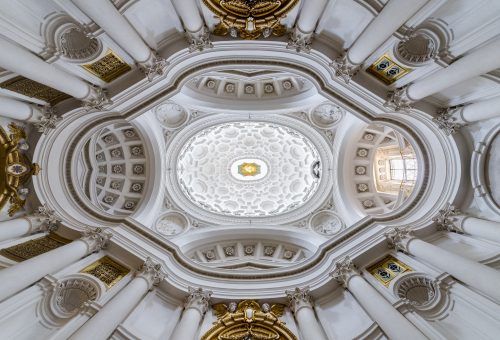Spectacle, Patronage, and the Jesuits in Baroque Rome- post 4
Ciao!
As this week was our
last week of excursions, it was bittersweet and very eventful. We were fresh off from our weekend trip to
Florence and Assisi, which was a breath of fresh air and extremely
enchanting. As birthplace of the
Renaissance, Florence is still a gorgeous and lively avenue for artist and art
lovers. An Assisi was charming,
relaxing, and had stunning scenery. The
Basilica of Saint Francis of Assisi was amazing and it was one of the only
Gothic churches on our tour. Its unique
architecture contains two levels that are comprised of an upper church and a
lower church. St. Francis’ crypt was
beautiful and created a space to meditate.
The walls of both levels are decorated with several frescos from medieval
artists. Our other main excursion for the weekend took us to the Uffizi Gallery
in Florence. The museum contains
priceless pieces from some of Italy’s most talented and brightest artists of
the Renaissance. The weekend was packed
full of art and history, which prepared us well for the excursions to come.https://scontent-ams3-
After
the weekend, we returned to Rome in order to continue studying the spectacle,
patronage, and the Jesuits in baroque Rome.
One of our first stops in the morning was to visit the Fontana del
Tritone. The baroque fountain was
created by Gian Lorenzo Bernini and commissioned by Pope Urban VIII. The fountain was an influential gesture by
Pope Urban VIII to illustrate that he appreciates the people and wants to be
remembered well by provided them access to a water source through an
aqueduct. The fountain contains a larger
than life version of Triton, the sea god and son of Poseidon. He is depicted as a merman and sitting upon
four large fish or dolphins that are entwined with the papal tiara and crossed
keys. The fountain is Bernini’s first freestanding
fountain and his last major commission before his death.
Our next stop after
the fountain was to the Santa Maria della Vittoria in order to catch a glimpse
of Bernini’s sculpture, Ecstasy of Saint
Teresa. The sculpture is a very good example of a piece from the High Roman
Baroque period. The sculpture was
commission by Pope Innocent X and the sculpture dramatizes the Carmelite,
Teresa of Avila, and her powerful religious experience with an angel piercing
her heart. It resides in a one of the
transept of the church.
We
then traveled to another baroque church called, San Carlo alle Quattro Fontane,
in order to examine Francesco Borromini’s design and architecture. He was
commissioned to design the church in the 17th century by Cardinal
Francesco Barberini. The exterior has a
concaved-convex façade that reveal it to by non-classic design. The complexities of the interior and exterior
have lead to the understanding that it was constructed in a way to convey
balance, rhythm, and harmonic qualities.
The church also emphasizes the structure of the building and not art of
decorations. The stark whiteness of the
walls lead the eye to focus on the intricate geometric shapes on the ceilings
and the congruence of the architecture. Our
adventures then took us to the San Vitale, an ancient basilica that was
consecrated by Pope Innocent I and then rebuilt by Pope Sixtus IV. The church walls are frescoed with images of
martyrdom and extremely below street level due to its age.
Our last
excursion for the day and the trip included a visit to the Palazzo Farnese, one
of the most important palaces of the High Renaissance. Initially built for the
Farnese family when Alessandro Farnese because Pope Paul III. Italian artists, such as Michelangelo and
Annibale Carracci, worked on its creation and frescos. Carracci’s dynamic combination of the baroque
and classical styles created an innovative and fresh way to create Renaissance
art. When Cardinal Farnese, the grandson
of Pope Paul III, lived in the palace he increased the size of the palace and
employed Michelangelo. His status is an
example of the cardinal nephew practice, which entails the elevation of status
to cardinal due to familial relations to a pope. The Hercules room and The Love of the Gods are two rooms that hold exquisite examples
from this time period. The sculpture of Hercules
is massive and illustrates some of the labors in the myth. Carracci’s fresco’s of The Love of Gods is immense and illustrates his dynamic approach by
illustrating how human bodies can dance or illustrate more natural movement,
compared to Michelangelo’s contorted figures.
That’s all for now, folks!!
Thank you for an amazing and unforgettable trip!
Love from Rome,
Kelsey Nicolosi







Comments
Post a Comment